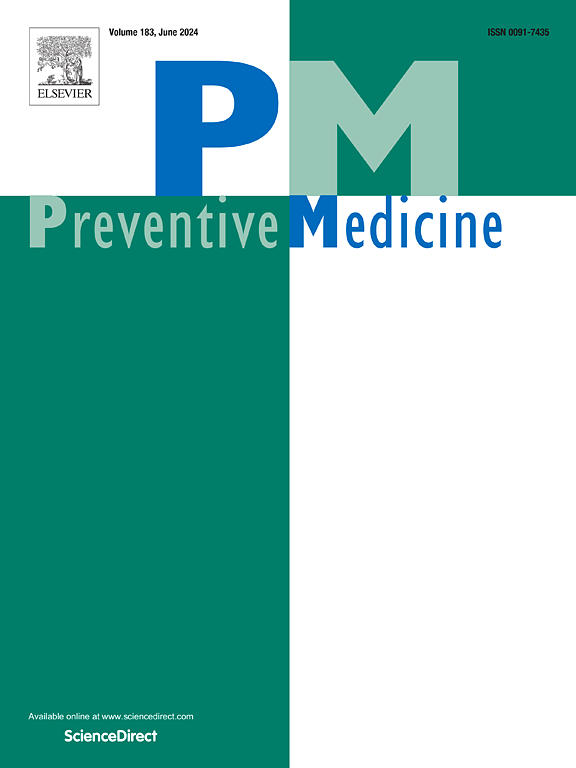Relationship between an adult-use Cannabis law and Cannabis use by type in a cohort of New Jersey young adults
IF 3.2
2区 医学
Q1 MEDICINE, GENERAL & INTERNAL
引用次数: 0
Abstract
Objectives
Limited research has evaluated the impact of cannabis policies on young adult cannabis use, after full implementation (retail outlets opened), nor on cannabis product type. This study examined the relationship between adult-use cannabis retail sales in New Jersey (United States) and young adult cannabis use by type.
Methods
Data on New Jersey young adults (18–23 years) were from the Policy Communication and Evaluation (PACE) New Jersey Study. Generalized estimating equations models estimated differences in prevalence of ever and past 30-day use of cannabis and sub-types before (Waves 1–3 [March–November 2021], n = 1439) and after (Wave 4 [June–July 2022], n = 1127) adult-use retail sales began.
Results
Ever cannabis use among New Jersey young adults was higher in the post-retail sales period than pre-sales (58.1 % vs. 48.9 %, p < 0.01). The odds of ever cannabis use were 42 % higher (95 % CI = 32 %–54 %) in the post-retail period. Ever use of dried herb (post vs. pre: 44.4 % vs. 38.5 %, p < 0.01), drinks (7.0 % vs. 4.8 %, p < 0.01), edibles (45.9 % vs. 35.6 %, p < 0.01), and topicals (6.4 % vs. 4.6 %, p < 0.05), and past 30-day edible use (11.8 % vs. 9.0 %, p = 0.01) were higher post-retail; use of other product types did not differ.
Conclusions
Cannabis use overall and among certain subtypes (e.g., edibles) increased among New Jersey young adults in the three months after adult-use cannabis retail sales began, demonstrating that increased access to legal cannabis for sale may encourage use. Continued monitoring is needed over longer follow-up periods in New Jersey and other states legalizing cannabis.
成人使用大麻法与新泽西州年轻人大麻使用类型之间的关系。
目的:有限的研究评估了大麻政策在全面实施(零售店开业)后对青少年大麻使用的影响,也没有评估大麻产品类型的影响。本研究调查了新泽西州(美国)成人大麻零售销售与青少年大麻使用类型之间的关系。方法:新泽西州年轻人(18-23 岁)的数据来自政策沟通与评估(PACE)新泽西州研究。广义估计方程模型估计了在成人零售销售开始之前(第1-3波[2021年3月- 11月],n = 1439)和之后(第4波[2022年6月- 7月],n = 1127),曾经和过去30天使用大麻的流行率和亚型的差异。结果:新泽西州年轻人在零售后的大麻使用量高于销售前的大麻使用量(58.1% %对48.9% %,p )。结论:在成人大麻零售开始后的三个月内,新泽西州年轻人的大麻总体使用量和某些亚型(例如,可食用)的使用量增加,表明增加合法大麻的销售可能会鼓励使用。在新泽西州和其他大麻合法化的州,需要在较长时间内继续进行监测。
本文章由计算机程序翻译,如有差异,请以英文原文为准。
求助全文
约1分钟内获得全文
求助全文
来源期刊

Preventive medicine
医学-公共卫生、环境卫生与职业卫生
CiteScore
7.70
自引率
3.90%
发文量
0
审稿时长
42 days
期刊介绍:
Founded in 1972 by Ernst Wynder, Preventive Medicine is an international scholarly journal that provides prompt publication of original articles on the science and practice of disease prevention, health promotion, and public health policymaking. Preventive Medicine aims to reward innovation. It will favor insightful observational studies, thoughtful explorations of health data, unsuspected new angles for existing hypotheses, robust randomized controlled trials, and impartial systematic reviews. Preventive Medicine''s ultimate goal is to publish research that will have an impact on the work of practitioners of disease prevention and health promotion, as well as of related disciplines.
 求助内容:
求助内容: 应助结果提醒方式:
应助结果提醒方式:


